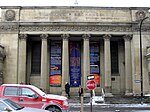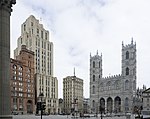Exchange Coffee House, Montreal
Defunct hotels in CanadaHistory of MontrealHotels in MontrealMontreal stubsOld Montreal ... and 1 more
Quebec building and structure stubs
First known as the "City Tavern," kept by Robert Tesseyman, this 19th-century hotel in Montreal, Quebec, Canada, was a popular meeting place of the Beaver Club before later becoming the Exchange Coffee House. In 1805, Samuel Gerrard proposed building Nelson's Column, Montreal here. The hotel was a common place of rest for transient travellers and Upper Canada merchants. It became the location of the first stock transactions in Montreal.
Excerpt from the Wikipedia article Exchange Coffee House, Montreal (License: CC BY-SA 3.0, Authors).Exchange Coffee House, Montreal
Rue Saint-François-Xavier, Montreal Ville-Marie
Geographical coordinates (GPS) Address Nearby Places Show on map
Geographical coordinates (GPS)
| Latitude | Longitude |
|---|---|
| N 45.503333333333 ° | E -73.556388888889 ° |
Address
Clandestino
Rue Saint-François-Xavier 436
H2Y 2T3 Montreal, Ville-Marie
Quebec, Canada
Open on Google Maps










